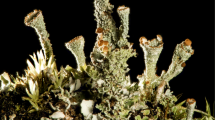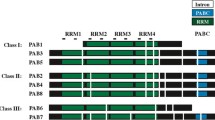Abstract
The life cycle of the red alga Porphyra purpurea alternates between two morphologically distinct phases: a shell-boring, filamentous sporophyte and a free-living, foliose gametophyte. From a subtracted cDNA library enriched for sporophyte-specific sequences, we isolated a cDNA encoding an unusual elongation factor 1α (EF-1α) that is expressed only in the sporophyte. A second EF-1α gene that is expressed equally in the sporophyte and the gametophyte was isolated from a genomic library. These are the only EF-1α genes detectable in P. purpurea. The constitutively expressed gene encodes and EF-1α very similar to those of most eukaryotes. However, the sporophyte-specific EF-1α is one of the most divergent yet described, with nine insertions or deletions ranging in size from 1 to 26 amino acids. This is the first report of a developmental stage-specific EF-1α outside of the animal kingdom and suggests a fundamental role for EF-1α in the developmental process.
Similar content being viewed by others
References
Baldauf SL, Palmer JD: Animals and fungi are each other's closest relatives: congruent evidence from multiple proteins. Proc Natl Acad Sci USA 90: 11558–11562 (1993).
Berchtold H, Reshetnikova L, Reiser COA, Schirmer NK, Sprinzl M, Hilgenfeld R: Crystal structure of active elongation factor Tu reveals major domain rearrangements Nature 365: 126–132 (1993).
Browning KS, Humphreys J, Hobbs W, Smith GB, Ravel JM: Determination of the amounts of the protein synthesis initiation and elongation factors in wheat germ. J Biol Chem 265: 17967–17973 (1990).
Cordeelis J: Elongation factor 1α, translation and the cytoskeleton. Trends Biochem Sci 20: 169–170 (1995).
Cottrelle P, Cool M, Thuriaux P, Price VL, Thiele D, Buhler JM, Fromageot P: Either one of the two yeast EF-1 alpha genes is required for cell viability. Curr Genet 9: 693–697 (1985).
Devereux J, Haeberli P, Smithies O: A comprehensive set of sequence analysis programs for the VAX. Nucl Acids Res 12: 387–395 (1984).
Dje MK, Mazabraud A, Viel A, Le-Maire M, Denis H, Crawford E, Brown DD: Three genes under different developmental control encode elongation factor 1-alpha in Xenopus laevis. Nucl Acids Res 18: 3489–3493 (1990).
Felsenstein J: Phylogeny Inference Package [PHYLIP 3.5C]. University of Washington, Seattle (1991).
Gonen H, Smith CE, Siegel NR, Kahana C, Merrick WC, Chakraburtty K, Schwartz AL, Ciechanover A: Protein synthesis elongation factor EF-1 alpha is essential for ubiquitin-dependent degradation of certain N alpha-acetylated proteins and may be substituted for by the bacterial elongation factor EF-Tu. Proc Natl Acad Sci USA 91: 7648–7652 (1994).
Hovemann B, Richter S, Walldorf U, Cziepluch C: two genes encode related cytoplasmic elongation factors 1 alpha (EF-1 alpha) in Drosophila melanogaster with continuous and stage specific expression. Nucl Acids Res 16: 3175–3194 (1988).
Kikuchi Y, Shimatake H, Kikuchi A: A yeast gene required for the G1-to-S transition encodes a protein containing an A-kinase target site and GTPase domain. EMBO J 7: 1175–1182 (1988).
Kinzy TG, Freeman JP, Johnson AE, Merrick WC: A model for the aminoacyl-tRNA binding site of eukaryotic elongation factor 1 alpha. J Biol Chem 267: 1623–1632 (1992).
Kjeldgaard M, Nyborg J: Refined structure of elongation factor EF-Tu from Escherichia coli. J Mol Biol 223: 721–742 (1992).
Knudsen SM, Frydenberg J, Clark BF, Leffers H: Tissuedependent variation in the expression of elongation factor-1 alpha isoforms: isolation and characterisation of a novel variant of human elongation-factor 1 alpha. Eur J Biochem 215: 549–554 (1993).
Kurasawa Y, Numata O, Katoh M, Hirano H, Chiba J, Watanabe Y: Identification of Tetrayhymena 14-nm filament-associated protein as elongation factor 1 alpha. Exp Cell Res 203: 251–258 (1992).
Kuriyama R, Savereide P, Lefebvre P, Dasgupta S: The predicted amino acid sequence of a centrosphere protein in dividing sea urchin eggs is similar to elongation factor (EF-1 alpha). J Cell Sci 95: 231–236 (1990).
Lee S, Wolfraim LA, Wang E: Differential expression of S1 and elongation factor-1α during rat development. J Biol Chem 268: 24453–24459 (1993).
Liboz T, Bardet C, Le-Van-Thai A, Axelos M, Lescure B: The four members of the gene family encoding the Arabidopsis thaliana translation elongation factor EF-1 alpha are actively transcribed. Plant Mol Biol 14: 102–110 (1990).
Liu QY, van derMeer JP, Reith ME: Isolation and characterization of phase-specific cDNAs from sporophytes and gametophytes of Porphyra purpurea (Rhodophyta) using subtracted cDNA libraries. J Phycol 30: 513–520 (1994).
Metz-Boutigue M-L, Reinbolt J, Ebel J-P, Ehresmann C, Ehresmann B: Crossliking of elongation factor Tu to tRNAPhe by trans-diamminedichloroplatinum (II). FEBS Lett 245: 194–200 (1989).
Mitman G, van derMeer JP: Meiosis, blade development and sex determination in Porphyra purpurea (Rhodophyta). J Phytol 30: 147–159 (1994).
Ohta K, Toriyama M, Miyazaki M, Murofushi H, Hosoda S. Endo S, Sakai H: The mitotic apparatus-associated 51-kDa protein from sea urchin eggs is a GTP-binding protein and is immunologically related to yeast polypeptide elongation factor 1 alpha. J Biol Chem 265: 3240–3247 (1990).
Pedersen S, Bloch PH, Rech S, Neidhardt FC: Patterns of protein synthesis in E. coli: a catalog of the amount of 140 individual proteins at different growth rates. Cell 14: 179–190 (1978).
Rice EL, Bird CJ: Relationships among geographically distant populations of Gracilaria verrucosa (Gracilariales, Rhodophyta) and related species. Physcologia 29: 501–510 (1990).
Riis B, Rattan SI, Clark BFC, Merrick WC: Eurkaryotic protein elongation factors. Trends Biochem Sci 15: 420–424 (1990).
Rost B, Sander C: Improved prediction of protein secondary structure by use of sequence profiles and neural networks. Proc Natl Acad Sci USA 90: 7558–7562 (1993).
Sambrook J, Fritsch EF, Maniatis T: Molecular Cloning: A Laboratory Manual, 2nd ed. Cold Spring Harbor Laboratory, Cold Spring Harbor, NY (1989).
Swofford DL: PAUP: Phylogenetic Analysis Using Parsimony version 3.0r. Illinois Natural History Survey, Champaign, IL (1991).
Swofford DL, Olsen GJ: In: Hillis DM, Moritz C (eds) Molecular Systematics, pp. 411–501. Sinauer Associates, Sunderland, MA (1990).
Travers A: Control of ribosomal RNA synthesis in vivo. Nature 244: 15–17 (1973).
Viel A, Le-Marie M, Philippe H, Morales J, Mazabraud A: Structural and functional properties of thesaurin a (42Sp50), the major protein of the 42S particles present in Xenopus laevis previtellogenic oocytes. J Biol Chem 266: 10392–10399 (1991).
Walldorf U, Hovemann B, Bautz EKF: F1 and F2: Two similar genes regulated differentially during development of Drosphila melanogaster. Proc Natl Acad Sci USA 82: 5795–5799 (1985).
Woolley P, Clark BFC: Homologies in the structure of G-binding proteins: a analysis based on elongation factor EF-Tu. Bio technology 7: 913–920 (1989).
Author information
Authors and Affiliations
Rights and permissions
About this article
Cite this article
Liu, Q.Y., Baldauf, S.L. & Reith, M.E. Elongation factor 1α genes of the red alga Porphyra purpurea include a novel, developmentally specialized variant. Plant Mol Biol 31, 77–85 (1996). https://doi.org/10.1007/BF00020608
Received:
Accepted:
Issue Date:
DOI: https://doi.org/10.1007/BF00020608




